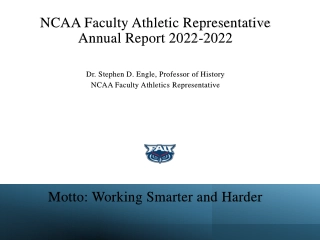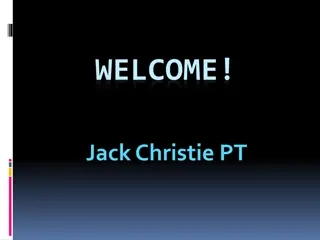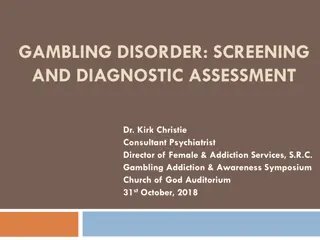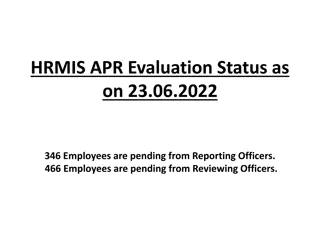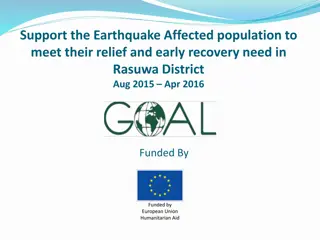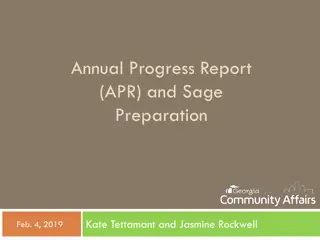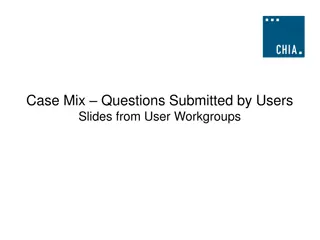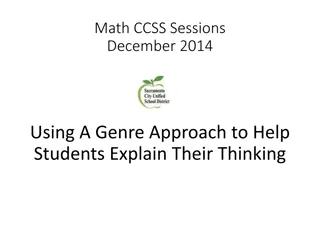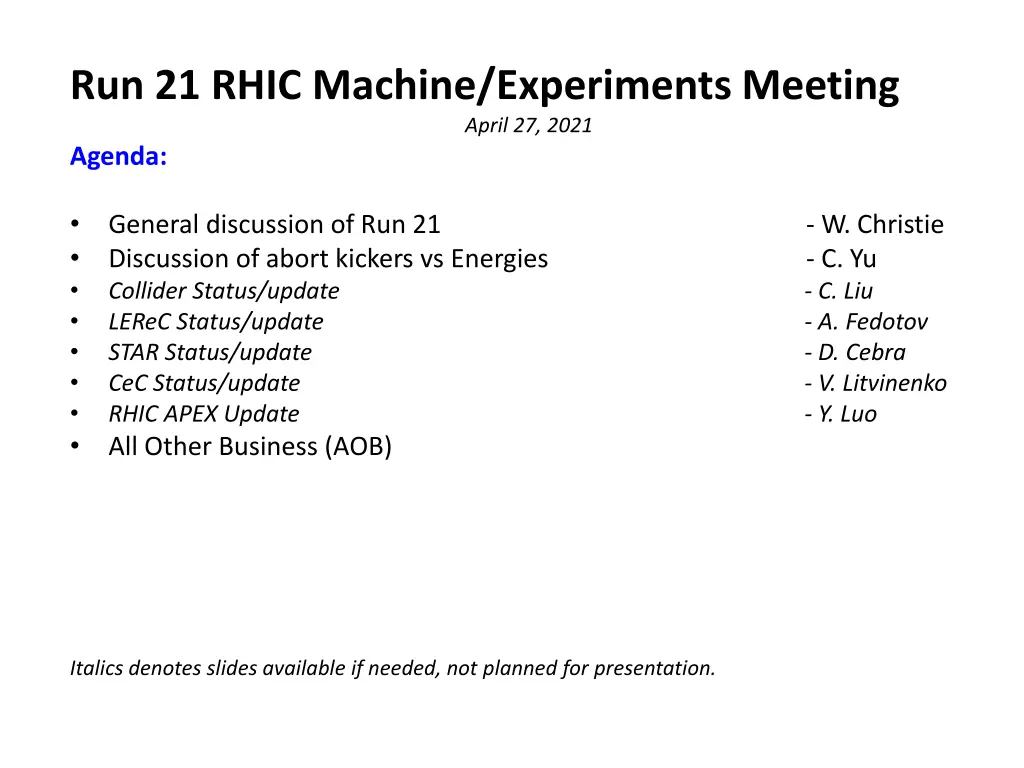
RHIC Machine Experiments Meeting Agenda
Explore the detailed agenda of the RHIC Machine Experiments Meeting on April 27, 2021, covering discussions on Run 21 progress, abort kickers, collider status, and updates on various components. Get insights into projections and data collection rates, along with estimates for achieving specific goals during the run.
Download Presentation

Please find below an Image/Link to download the presentation.
The content on the website is provided AS IS for your information and personal use only. It may not be sold, licensed, or shared on other websites without obtaining consent from the author. If you encounter any issues during the download, it is possible that the publisher has removed the file from their server.
You are allowed to download the files provided on this website for personal or commercial use, subject to the condition that they are used lawfully. All files are the property of their respective owners.
The content on the website is provided AS IS for your information and personal use only. It may not be sold, licensed, or shared on other websites without obtaining consent from the author.
E N D
Presentation Transcript
Run 21 RHIC Machine/Experiments Meeting April 27, 2021 Agenda: General discussion of Run 21 Discussion of abort kickers vs Energies Collider Status/update LEReC Status/update STAR Status/update CeC Status/update RHIC APEX Update All Other Business (AOB) - W. Christie - C. Yu - C. Liu - A. Fedotov - D. Cebra - V. Litvinenko - Y. Luo Italics denotes slides available if needed, not planned for presentation.
A look at this years data collection rate to date Collecting ~ 1.4 M evts/day Over the past week, we re averaging about 13 hours/day of STAR DAQ hours/day. The store average rate, averaged over a week, is about 30 Hz. Hours/day down, and rate a bit up compared to last week.
Discussion on projections going forward In first thirteen Cryo weeks, twelve of which are since Physics running was declared, STAR has collected ~92.4 Mevts. STAR will add to this 3.2 Mevts from Run 20 for the 100 Mevt goal, so ~ 4.4 Mevts to go. For estimating purposes, one can then use the two metrics, average DAQ hrs/day and average Good evt rate/Fill to project days needed to achieve the goal. IF we can achieve/maintain an average of 13 DAQ hrs/day, and we can achieve an average good evt rate/Fill of 30 Hz, to collect an additional 14.8 Mevts will take: 4.4 Mevts/(13 hrs/day x 3600 sec/hr x 30 evts/sec) = ~3.1 days
Discussion on projections going forward If we can maintain the parameters used on the previous page (13 hrs/day running and 30 Hz), this would mean that we d need a total of ~ 13.7 weeks of our 24 week run to achieve the 7.7 GeV data set goal. A fairly accurate estimate is that CeC will still have about 1.2 weeks or so still to go once the 7.7 GeV program concludes. IF one assumes CeC has 1.2 weeks to go, the estimates above project that the 7.7 GeV data set will complete ~ 13.7 weeks into the run. Adding on the estimated further 1.3 weeks for CeC totals to ~ 14.9 weeks. This leaves about 9.1 weeks for the remaining physics goals, the remaining APEX time, and finally the warmup. The utility of the above estimate is that it allows us to scale from observed performance to projected weeks needed. Suggest that weekly averages for the two parameters are most useful for projections.
List of components for the 2021 RHIC Run (Aid for discussion) STAR Physics program 7.7 GeV Au on Au Fixed target 200 GeV O on O 17.3 GeV Au on Au 3.85 GeV (3 GeV FXT) CeC Program APEX Low Energy APEX 100 GeV APEX Other TOTAL - 13.7 weeks* (~95% of goal to date) - 1 week - 1 week (+ few days setup) - 2.5 weeks - 3 weeks - 2 weeks (~35% expended to date*) - .66 weeks (~58% expended to date) - 70 hours (~ 66% expended to date) - 41 hours - ? = 24 weeks (~54% expended to date) Blue Purple Black * = Physics programs presented to the PAC, priority ordered = Has historically been a part of all RHIC runs = Beam dev. and discretionary = RHIC Ops accounting = Currently running
Estimate of when the 7.7 GeV Data Set goal will be reached As of now, STAR needs to accumulate ~ 4.4 Mevts to reach the goal. STAR accumulates ~ 107 kevts/DAQ hr. # of DAQ hrs needed = 4.4 Mevts/107 kevts/DAQ hr = 41 DAQ hrs. Estimated DAQ hrs/day going forward: Rest of Tuesday ~ 5.4 hrs Wednesday ~ 8 hrs Thursday ~ 6.5 hrs Friday Saturday ~ 7.1 hrs Plot of Daq hrs/day for 7.7 GeV Physics running ~ 14 hrs Blue dots = This week Red line = Average for run Using the ratio of .67 Daq hrs/clock hr for weekends, this estimate indicates that we should reach the 7.7 GeV data set goal by about 11 am Saturday morning, round to 12 noon Saturday. Plot courtesy of J. Dunlop
All Other Business (AOB) Discussion of Abort kicker configuration vs Energies for upcoming programs. AOB


